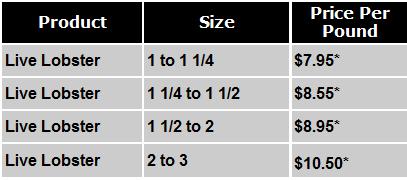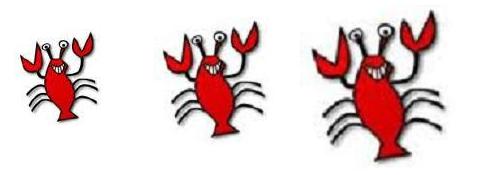Lobster-nomics
 One of the benefits of travelling around New England is enjoying lobster in its many forms: steamed, on a roll, in a bisque, biting your toe. But while shopping at a fishmonger one evening, I was somewhat baffled to see a sign like the one at the right. It seems that the price per pound for lobster varies depending on the lobster’s size!
One of the benefits of travelling around New England is enjoying lobster in its many forms: steamed, on a roll, in a bisque, biting your toe. But while shopping at a fishmonger one evening, I was somewhat baffled to see a sign like the one at the right. It seems that the price per pound for lobster varies depending on the lobster’s size!
Why is this? Why should a larger lobster cost more per pound than a smaller lobster? Large or small, apples are still $1.69 per pound; the same goes for onions, chicken, and most other things.
What’s different about lobsters? My assumption is that, in a lobster, the ratio of meat to non-meat (shell, antennae, veins, etc) is constant, that is, the same for any size lobster. Thus, since you are paying for meat, you should then pay the same price per pound for any lobster. But maybe that’s not the case. Maybe in a small, one pound lobster, there is, say, 8 oz of meat and 8 oz of shell, but in a lobster twice the size, there is 20 oz of meat and 12 oz of shell.
I guess I assumed that the geometry of the lobster is essentially the same regardless of the size; in other words, that all lobsters are geometrically similar. Thus, the price-per-pound should be lobster-independent. But maybe I’m wrong. Is it really the case that, as lobster size increases, the amount of meat and the amount of non-meat increase at different rates?
Anyone have any other theories?

8 Comments
Ben · September 13, 2010 at 10:08 am
Another theory: because of overfishing, lobsters rarely grow to be very large. So, large lobsters are significantly (i.e. more than linearly) rarer than small ones, which allows charging more than “price per pound” for them.
You’re right, though. This is a weird way of determining prices. It looks like the price per pound is approximately a linear function of weight, something like P/w = 5.95 + 2.00*w. This means that the actual price is a quadratic function of weight. I bet sellers of other products wish they could charge that way!
I have a story of parabolas in nature from my fluid mechanics lab that I’ve been meaning to send you – expect an email as soon as I can write it up coherently.
MrHonner · September 13, 2010 at 3:59 pm
But just because they are rarer shouldn’t make them cost more per pound, should it? I mean, the same argument could be made about big cows. A 10-ft tall cow might be rare (no pun intended), but I’m still expecting to pay the same price-per-pound for hamburger.
And boy, a good reason to have price be a quadratic function of weight would certainly make any producer happy. Let’s not give anyone any ideas.
I look forward to your fluid-mechanical parabola.
Heidi Reich · September 28, 2010 at 7:18 pm
Because the meat of a big lobster tastes better. Just like magnums of wine have BETTER wine than regular bottles. The whole is not always the sum of the parts.
MrHonner · September 28, 2010 at 10:18 pm
I think that’s a marketing ploy. To be honest, the whole issue of sea-insects as expensive cuisine is pretty much marketing, as well.
The whole is usually the sum of its parts.
Hilary · September 29, 2010 at 10:07 am
I think it’s because with bigger lobsters you get bigger chunks of meat, which is considered better. Think of a lobster roll with discernible chunks of meat compared to minced.
Sort of like how walnut pieces are cheaper by the pound than whole walnuts.
Alan · September 30, 2010 at 11:02 pm
Well, if you tried to create an analogy, think of it from a technological point of view. In these modern days, several people have I-Pods, I-Pads, I-Phones, and so on. However, is every I-Pod 3rd Generation the same cost? No. For 8gb, it’s $170 and for 64gb it’s $270. The prices may be off, since these may be prices for “used” I-Pods Third generation. However, the point is the same. The price increases as storage increases. Analogously, the price of lobsters increases as the meat increases. This may be a simple approach, but it does make it a bit easier to understand. If there’s more meat, the corresponding, inedible parts change. Thus, it is reasonable to charge more for more meat. If you buy a large milk carton, there’s more milk. As a result, a smaller carton should be cheaper. if the prices were not different, then everyone would buy the larger carton and the smaller carton would have no purpose. The same applies to the lobsters, It’s all about price per quantity.
Sean · October 2, 2010 at 11:52 am
I like this analogy as it is easy to expand on. What you have just pointed out is basic economics. For example, let’s say a 1-gallon carton of milk costs $2.30 and a 2-gallon carton costs $4.00. Obviously, it takes no genius to realize that buying the 2-gallon carton is more cost-efficient. However, the reason the inferior option exists is to take advantage of those “strapped for money” who are attempting to meet their milk needs for a short-term.
Alan · October 2, 2010 at 5:19 pm
Hmmm, I wonder if that could apply to the lobster case, where the amount of meat could appeal to different people, where one person might want a small lobster where two people sharing may want a larger lobster, when relating to your expansion. A simple dinner is short-term. Unless you’ll be having lobster for left-overs tomorrow night, the “inferior” or lobster with less meat is available. On the other hand, I don’t think it really matters. As long as there are sufficient lobsters for consumers, then it’s all about catching that sufficient amount and pricing them correctly.